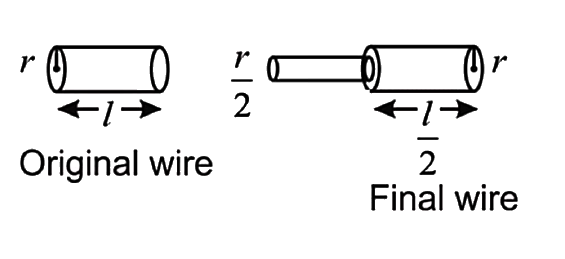A wire has a resistance R. What wil will be its resistance if it is stretched to double its length?
To find the resistance of a wire when it is stretched to double its length, we can follow these steps:
Step 1: Understand the relationship between resistance, length, and area
The resistance R of a wire is given by the formula:
R=ρLA
where:
- R is the resistance,
- ρ is the resistivity of the material,
- L is the length of the wire,
- A is the cross-sectional area of the wire.
Step 2: Define the initial parameters
Let:
- Initial length of the wire = L
- Initial area of the wire = A
- Initial resistance = R
From the formula, we have:
R=ρLA
Step 3: Determine the new length after stretching
When the wire is stretched to double its length, the new length L′ becomes:
L′=2L
Step 4: Apply the principle of volume conservation
When the wire is stretched, its volume remains constant. The volume of the wire can be expressed as:
Volume=Area×Length
Thus, the initial volume Vi is:
Vi=A×L
And the final volume Vf after stretching is:
Vf=A′×L′=A′×(2L)
Setting the initial volume equal to the final volume gives:
A×L=A′×(2L)
Step 5: Solve for the new area
From the volume conservation equation:
A×L=A′×(2L)
We can cancel L from both sides (assuming L≠0):
A=2A′
Thus, the final area A′ is:
A′=A2
Step 6: Calculate the new resistance
Now we can find the new resistance R′ using the new length and area:
R′=ρL′A′=ρ(2L)A/2
This simplifies to:
R′=2ρLA/2=2ρL⋅2A=4ρLA
Since we know R=ρLA, we can substitute:
R′=4R
Conclusion
The resistance of the wire when stretched to double its length is:
4R
The resistance R of a wire is given by the formula:
R=ρLA
where:
- R is the resistance,
- ρ is the resistivity of the material,
- L is the length of the wire,
- A is the cross-sectional area of the wire.
Let:
- Initial length of the wire = L
- Initial area of the wire = A
- Initial resistance = R
R=ρLA
When the wire is stretched to double its length, the new length L′ becomes:
L′=2L
When the wire is stretched, its volume remains constant. The volume of the wire can be expressed as:
Volume=Area×Length
Thus, the initial volume Vi is:
Vi=A×L
And the final volume Vf after stretching is:
Vf=A′×L′=A′×(2L)
Setting the initial volume equal to the final volume gives:
A×L=A′×(2L)
From the volume conservation equation:
A×L=A′×(2L)
We can cancel L from both sides (assuming L≠0):
A=2A′
Thus, the final area A′ is:
A′=A2
Now we can find the new resistance R′ using the new length and area:
R′=ρL′A′=ρ(2L)A/2
This simplifies to:
R′=2ρLA/2=2ρL⋅2A=4ρLA
Since we know R=ρLA, we can substitute:
R′=4R
The resistance of the wire when stretched to double its length is:
4R
Topper's Solved these Questions
- CURRENT ELECTRICITYBOOK - DC PANDEY ENGLISHCHAPTER - CURRENT ELECTRICITYEXERCISE - Example Type 1
2 Videos
- CURRENT ELECTRICITYBOOK - DC PANDEY ENGLISHCHAPTER - CURRENT ELECTRICITYEXERCISE - Example Type 2
1 Video
- COMMUNICATION SYSTEMBOOK - DC PANDEY ENGLISHCHAPTER - COMMUNICATION SYSTEMEXERCISE - Subjective
11 Videos
- ELECTROMAGNETIC INDUCTIONBOOK - DC PANDEY ENGLISHCHAPTER - ELECTROMAGNETIC INDUCTIONEXERCISE - Medical entrances gallery
25 Videos
Similar Questions
When a wire is stretched to double its length, then
View SolutionA wire has a resistance R. What will be its resistace if (a) it is double on itself and (b) it is stretched so that (i) its length is double and (ii) its radius is halved.
View SolutionThe resistance of a wire is R ohm. What will be its new resistance if it is stretched to n times its original length ?
View SolutionA wire of given metarial having length l and ares of cross-section A has a resistance of 4Ω. What would be the resistance of another wire of the same meterial having length l/2 and area of cross-section 2A ?
View SolutionA wire of length l has a resistance R. If half of the length is stretched to make the radius half of its original value, then the final resistance of the wire is

View SolutionA metal wire has a resistance of 35Ω. If its length is increased to double by drawing it, then its new resistance will be
View SolutionA wire has a resistance R. Find new resistance,
(i) if radius of cross-section of a cylindrical wire is doubled, then find ratio of initial to final resistance.
(ii) if length of wire is increased by 10%, then find the percentage increase in its resistance.
(iii) if length of wire is increased by 20%, then find the percentage increase in its resistance.

View SolutionSpecific resistance of a wire depends on its
View SolutionSpecific resistance of a wire depends on its
View SolutionA uniform wire of resistance =3Ω and length l is stretched to double its length. Now it is bent to form a circular loop and two point P&Q lies on the loop such that they subtend 60∘ angle at centre. The equivalent resistance between two point P & Q is:
View Solution